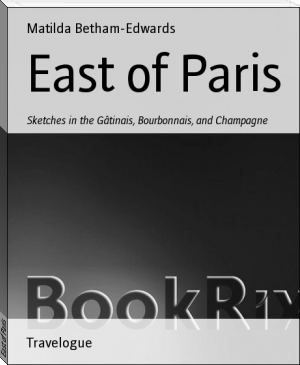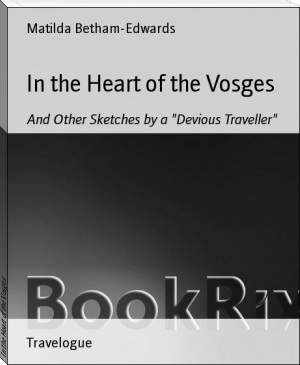The Roof of France by Matilda Betham-Edwards (romantic story to read txt) 📖

- Author: Matilda Betham-Edwards
Book online «The Roof of France by Matilda Betham-Edwards (romantic story to read txt) 📖». Author Matilda Betham-Edwards
Valence is beautifully situated. [Footnote: In the early part of this century the Rhone threw up gold-dust here. The beaver, be it also mentioned, had his home then on the banks of this river, but it lived in isolation, showing little of the intelligence of the Canada beaver.] Facing the river and tawny, abrupt rocks rises the splendid panorama of the French Alps. Here we ought to stay, were we not in such feverish flurry to reach the Causses. And here we leave more than half our passengers and merchandise. The cook, having now nothing to do, comes on deck to chat with a friendly traveller. I may as well mention that we fare as well on this little steamer as at a second-class table- d'hote. There is a small dining-room below, as well as a very fairly comfortable saloon. The attendants are exceedingly civil, and charges regulated by a tariff.
As an instance of the prevailing desire to please, I cite the following piece of amiability on the part of the chef. I had given tea and a teapot, with instructions, to the waiter. The chef, however, anxious that there should be no blunder, came up to me and begged for information at first hand.
'Pray excuse me,' he said; 'but I did not understand whether the milk and sugar were to form part of the decoction.'
I gave him a little dissertation on tea-making, with the result that future travellers by the Gladiateur will obtain a fragrant cup admirably prepared. Even a French chef cannot be expected to know everything in the vast field of cookery.
Below Valence the scenery changes. The hills on either side of the river recede, and we look above low reaches and lines of poplar upon the far-off mountain-range of Dauphine and Savoy. Here and there are little farmsteads close to the shore, with stacks of wheat newly piled and cattle grazing--everywhere a look of homely plenty and repose. The river winds in perpetual curves, giving us new horizons at every turn.
Lavoutte, on the right bank, is a picturesque congeries of red-tiled houses massed round a square chateau. The town indeed looks a mere appendage of this chateau, so conspicuous is the ancient stronghold of the Vivarais. Livron, perched on a hill, looks very pretty. Soon we come to perhaps the grandest ruin cresting the bank of the Rhone, the donjon and chateau fort of Rochemaure, standing out formidably from the dark, jagged peaks, running sheer down to the river's edge.
After Le Teil is passed the clouds gradually clear. We have the deep warm blue of a southern sky and burning sunshine.
Viviers--ancient capital of the Vivarais, to which it gave the name--is most romantically placed on the side of a craggy hill, its ancient castle and old Romanesque cathedral conspicuous above the house-roofs. Just above the verdant river-bank run its mediaeval ramparts tapestried with ivy, the yellowish stone almost the colour of the rocks.
The scenery here is wild and striking. Far away the grand snow-tipped Mont Ventoux, the limestone cliffs dazzlingly white against the warm heavens, deep purple shadows resting on the vine-clad slopes, whilst close to the water's edge are stretches of velvety turf and little shady dells. At one point the opposite coasts are as unlike in aspect as summer and winter; the right bank all grace and fertility, the left all barrenness and desolation. And still we have the noble river to ourselves as it winds between rock and hill. Pont St. Esprit is another old-world town with a wonderful old bridge, making a charming picture. It stands close to the water's edge, the houses grouped lovingly round its ancient church with tall spire. Here we do at last meet a steamer bound for Valence.
After leaving Pont St. Esprit the scenery grows less severe, till by degrees all sternness is banished, and we see only a gentle pastoral landscape on either side.
Bagnols, with its handsome old stone bridge, church, with perforated tower, facing the river, makes a quaint and picturesque scene. This curious old town, one of the most characteristic passed throughout the entire journey, lies so close to the water's edge that we could almost step from the steamer into its streets. Meantime, the long, bright afternoon, so rich in manifold impressions, draws on; cypresses and mulberry-trees announce the approach to Avignon. A golden softness in the evening sky, a heavy warmth and languor in the air, proclaim the South. Every inch of the way is varied and rememberable. Feudal walls still crest the distant heights, as we glide slowly between reedy banks and low sandy shores towards the papal city.
At last it comes in sight, rather more than twelve hours since quitting the quay of Lyons, and well rewarded were we for having preferred the slower water-way to the four hours' flight in the railway express.
The approach to Avignon by the Rhone may be set side by side in the traveller's mind with the first glimpse of Venice from the Adriatic, or of Athens from the AEgean.
The river, after winding amid cypress-groves, makes a sudden curve, and we see all of a sudden the grand old Italian-looking city, its watch- towers, palaces, and battlements pencilled in delicate gray against a warm amber sky, only the cypresses by the water's edge making dark points in the picture. Far away, over against the city towers, the stately snow-crowned Mont Ventoux and the violet hills shutting in Petrarch's Vaucluse. How warm and southern--nay, Oriental--is the scene before us, although painted in delicatest pearly tints! It is difficult to believe that we are still in France; we seem suddenly to have waked up in Jerusalem!
CHAPTER IV. AVIGNON AND ORANGE.
My first business at Avignon was, of course, to visit the tomb of our great countryman, John Stuart Mill.
As we drive to the cemetery this cloudless August day there is little to remind us of northern latitudes: warm yellow walls, burning blue heaven, venerable fig-trees white with dust, peach and olive orchards-- all combine to conjure up a vision of the far-off East. The perpetual wind, however, cools the air, and if it has not the delicious freshness of the desert breeze tasted towards nightfall near Cairo, at least it makes August in that apparently tropic region bearable. Avignon should without doubt be visited in the height of summer, otherwise we lose this Oriental aspect, which is its most striking and, at the same time, most beautiful characteristic.
Passing the colossal palace of the popes--pity such superb masonry should be linked with the memories of crimes so horrible!--we reach the public gardens, containing the statue of a comparatively humble individual, who did more for the public weal than perhaps all the popes and anti-popes put together. This is Althen, who, by the introduction of the madder-root into France, promoted the peaceful industry and wellbeing of thousands of honest families. From the lofty terrace of this promenade--a natural precipice overlooking the river--we obtain a glorious panorama--the entire city, with its towers, palace, and churches, spread before us as a map, the glory of the Dauphinnois Alps, the magnificent Mont Ventoux stretching across the northern horizon, under the shadow of its sunny crest the pale violet hills of Vaucluse, and, to complete the picture, the Rhone, silvery bright--I protest it is not always muddy as some writers insist!--flowing swiftly between green banks towards the sea.
An avenue of stone pines leads to the cemetery--announced by flower- stalls and stonemasons' yards--and we soon find the head-gardener--an ancient man, proud to show us the tomb of the 'grand Anglais.'
'Do my country-people often come here to pay their respects to this grave?' I asked.
'Oh, many, many!' he said; 'and the demoiselle, his daughter--it is she who sees to everything. She is always coming. Never was any grave so cared for, as you will see.'
He was right. The sarcophagus of pure white marble stands in the midst of a tiny garden, exquisitely kept and railed in, with gate well- locked. The well-known inscription inscribed by Stuart Mill to the memory of his wife cannot be deciphered from outside the enclosure, and no one, under any circumstances whatever, is permitted to enter it; but the name of the noble apostle of liberty stands out bold and clear, and may be seen from a distance. The flower-borders around the tomb were bright with late summer and autumn flowers; not a seared leaf, not an unsightly weed anywhere. The reverential care bestowed on this grave is delightful to witness. Two English girls lie buried near the great champion of women and of liberty of thought. Rare flowers--roses and lilies--were not to be had, so I purchased a homely garland of zinnias and China asters, and laid it just outside the little railing. In paying this modest tribute to the memory of John Stuart Mill I fulfilled a wish very dear to my heart. One other pilgrimage of the like kind I would fain make did not wide seas intervene. I should like to place a wreath on the tomb of another apostle of liberty--the dauntless, the self-immolating Colenso!
Schiller, great in poetry as in prose, says: 'The larger portion of humanity are too much concerned with the struggle for bare existence to occupy themselves with the search after truth.' Let us, then, rejoice in the memory of those who have consecrated their existences to this lofty task!
Beautiful as is Avignon for a burial-place, we wonder how anyone could from choice live here. The perpetual mistral-like wind, the dazzling glare, the white dust, the malodorous streets of the old town, do not at any rate invite a long stay during the dog-days, and much of its picturesqueness would be lost in winter. With the prospect of the breezy Roof of France ever before us, we certainly felt little disposed to linger, in spite of our comfortable quarters and another attraction not mentioned in guide-books. I allude to the great beauty of the people, especially of the young girls and children. We seemed here to have touched the first note of a gradually ascending scale of beauty, the climax awaiting us in the mountain fastnesses of the Lozere. In and around Avignon we saw many a girl beautiful as one of Raphael's Madonnas, many a child lovely as an angel. We could not paint these charming heads, we could not make the acquaintance of their possessors; but it was delightful to obtain such glimpses of beauty by the way--to feel one's self in a living portrait-gallery of beauty. The great neatness and tidiness of the country people, and the absence of vagrancy, are very striking. Wherever we go, we see evidence of an existence laborious perhaps in the extreme, yet one of wholesomeness and content.
Strange to say, chemical science has proved as disastrous to the rural population round about Avignon as the phylloxera has done in other parts of the department. The supersession of madder by aniline dyes has, indeed, for a time almost ruined the small farmers of Vaucluse.
'Ah!' said an elderly man to me, 'in former days the madder made up for everything. It was the harvest of the year. If a peasant's corn was blighted, or potatoes and fruit crops failed, the madder was there to take to market. The madder paid





Comments (0)